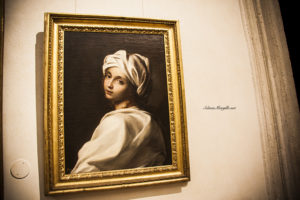Capital Beheadings in Rome: Beatrice Cenci
Italian Version below*
A packed crowd, opposed to an unjust and merciless execution, crowded on the square of Castel Sant’Angelo to witness the brutal death of Beatrice Cenci, on 11 September 1599.
Beatrice, daughter of Count Francesco Cenci, after years of abuse and violence, had organized the killing of his father with her stepmother and brothers, trying to pass the incident as a simple accident and not a premeditated murder.
The epilogue was not what was hoped for. The real intentions of the gesture emerged and Pope Clement VIII, at the papal throne at that time, the bitter enemy of the Cenci seized the opportunity to condemn Beatrice.
Beatrice’s face is known to us thanks to the famous portrait of the Bolognese painter Guido Reni, who became part of the Barberini collection in 1818.
There was a long debate about the authorship of the painting and the moment of execution. There are those who claim it was made just before the death and those who favor a posthumous execution during one of the Roman stays of Guido Reni. The artist decided to portray her as a muse, with a white headdress and a melancholy gaze, in all her candor as a young 22-year-old.
After the execution, which took place with the sword, Beatrice’s body was buried anonymously as was convenient for those executed below the main altar of San Pietro in Montorio. The head was placed on a silver plate and adorned with roses. During the first Roman Republic, in 1798, the French soldiers who had occupied the city profaned the tomb, and the bones were scattered.
The myth of Beatrice is still alive in the Roman tradition … there are those who tell of her “presence” in Castel Sant’Angelo every 11 September.
Maybe not everyone knows that … During the execution, among the angry crowd, according to the chronicles, there was also the young Caravaggio who drew inspiration for the painting by Giuditta and Holofernes.
All rights reserved*
—————————————————————————-
Una folla gremita, contraria ad un’esecuzione capitale ingiusta ed impietosa, si accalcò sulla piazza di Castel Sant’Angelo per assistere alla brutale morte di Beatrice Cenci, l’11 settembre del 1599.
Beatrice, figlia del Conte Francesco Cenci, dopo anni di soprusi e violenze, aveva organizzato con la matrigna ed i fratelli l’uccisione del padre, cercando di far passare l’accaduto come un semplice incidente e non un omicidio premeditato.
L’epilogo non fu quello sperato. Emersero le reali intenzioni del gesto e papa Clemente VIII, al soglio papale in quel momento, acerrimo nemico dei Cenci colse al volo l’occasione per condannare Beatrice.
Il volto di Beatrice ci è noto grazie al celeberrimo ritratto del pittore bolognese Guido Reni, entrato a far parte della collezione Barberini nel 1818.
Si è dibattuto a lungo sulla paternità del dipinto e sul momento dell’esecuzione. C’è chi sostiene sia stato realizzato poco prima della morte e chi propende per un’esecuzione postuma durante uno dei soggiorni romani di Guido Reni. L’artista decise di ritrarla come una musa, con il copricapo bianco e lo sguardo malinconico, in tutto il suo candore di giovane 22 enne.
Il corpo di Beatrice dopo l’esecuzione, avvenuta con la spada, fu sepolto in forma anonima come si conveniva per i giustiziati al di sotto dell’altare maggiore di San Pietro in Montorio. La testa fu poggiata su di un piatto d’argento ed ornato di rose. Durante la prima Repubblica Romana, nel 1798, i soldati francesi che avevano occupato la città, profanarono la tomba e le ossa andarono disperse.
Il mito di Beatrice è tutt’ora vivo nella tradizione romana… c’è chi racconta della sua “presenza” a Castel Sant’Angelo ogni 11 Settembre..
Forse non tutti sanno che…. Durante l’esecuzione, tra la folla inferocita, secondo le cronache c’era anche il giovane Caravaggio che trasse ispirazione per il dipinto di Giuditta ed Oloferne.
InfoSite: Galleria Barberini
Sostieni la #culturachevince, aiuta la condivisione.
